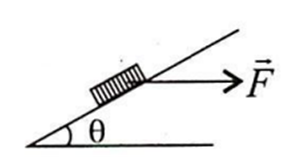 Multiple Choice Questions
Multiple Choice QuestionsUniversal time is based on
rotational effect of the earth about its axis
vibrations of cesium atom
orbital motion of the earth around the sun
oscillation of quartz crystal
A liquid of density 800 kg/m3 is filled in a cylindrical vessel upto a height of 3 m. This cylindrical vessel stands on a horizontal plane. There is a circular hole on the side of the vessel. What should be the minimum diameter of the hole to move the vessel on the floor, if plug is removed. Take the coefficient of friction between the bottom of the vessel and the plane as 0.5 and total mass of vessel plus vessel as 95 kg.
0.107 m
0.053 m
0.206 m
0.535 m
The figure shows a horizontal force F acting on a block of mass M on an inclined plane (angle θ). What is the normal reaction N on the block?

mg sinθ + F cosθ
mg sinθ - Fcosθ
mg cosθ - F sinθ
mg cosθ + F sinθ
Assertion: Pseudo force is an imaginary force which is recognised only by a non-inertial observer to explain the physical situation according to Newton's laws.
Reason: Pseudo force has no physical origin, i.e., it is not caused by one of the basic interactions in nature. It does not exist in the action-reaction pair.
If both assertion and reason are true and reason is the correct explanation of assertion.
If both assertion and reason are true but reason is not the correct explanation of assertion.
If assertion is true but reason is false.
If both assertion and reason are false.
Assertion: When a charged particle moves in a circular path. It produces electromagnetic wave.
Reason: Charged particle has acceleration
If both assertion and reason are true and reason is the correct explanation of assertion.
If both assertion and reason are true but reason is not the correct explanation of assertion.
If assertion is true but reason is false.
If both assertion and reason are false
The radii of circular paths of two particles of same mass are in ratio 6 : 8 then what will be velocities ratio if they have a constant centripetal force?
Assertion: Use of ball bearing between two moving parts of a machine is a common practice.
Reason: Ball bearing reduces rolling friction and provides good stability.
If both assertion and reason are true and reason is the correct explanation of assertion.
If both assertion and reason are true but reason is not the correct explanation of assertion.
If assertion is true but reason is false.
If both assertion and reason are false.
Assertion: Centripetal force is always required for motion in curved path.
Reason: On a banked curved track, vertical component of normal reaction provides the necessary centripetal force.
If both assertion and reason are true and reason is the correct explanation of assertion.
If both assertion and reason are true but reason is not the correct explanation of assertion.
If assertion is true but reason is false.
If both assertion and reason are false.
A block of mass 2 kg is placed on the floor. The coefficient of static friction is . If a force of N is applied on the block parallel to the floor, the force of friction between the block and the floor is (g = 10 ms-2 )
N
2 N
8 N
Zero
A cyclist is moving in a circular track of radius 80 m with a velocity of 36 km h-1. He has to lean from the vertical approximately through an angle (Take g = 10 m s-2 )
tan-1 (4)
tan-1(1/8)
tan-1(1/4)
tan-1(2)
